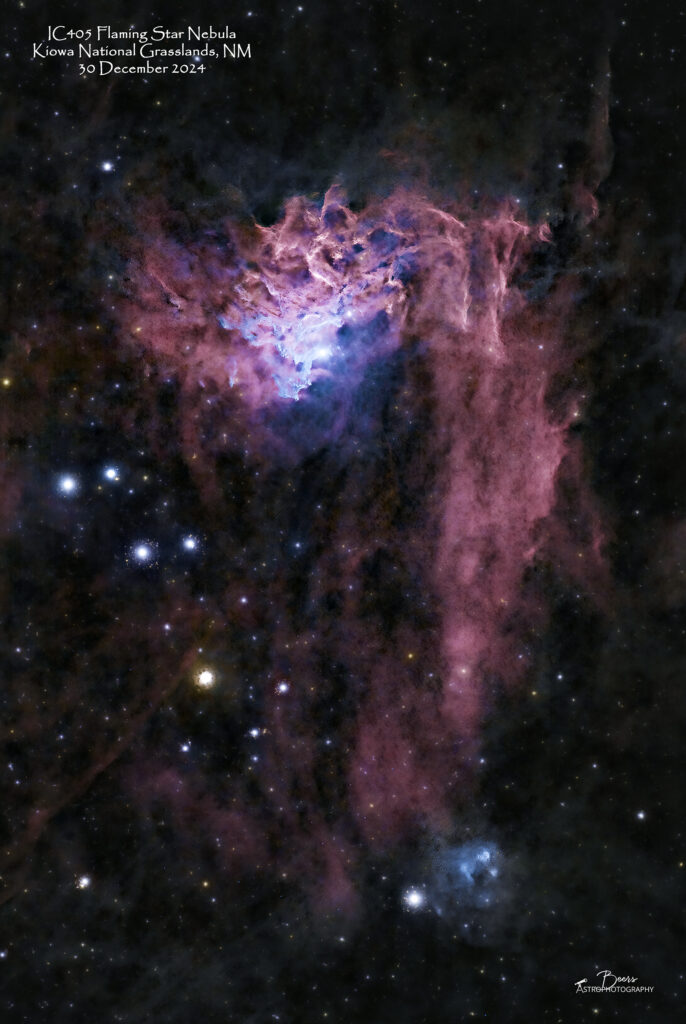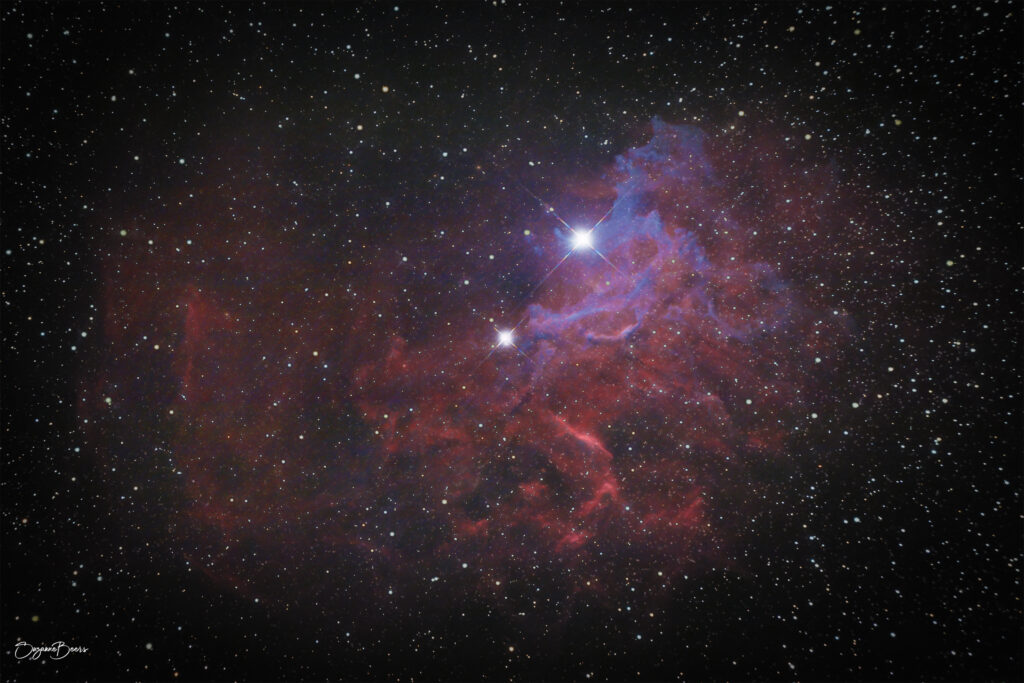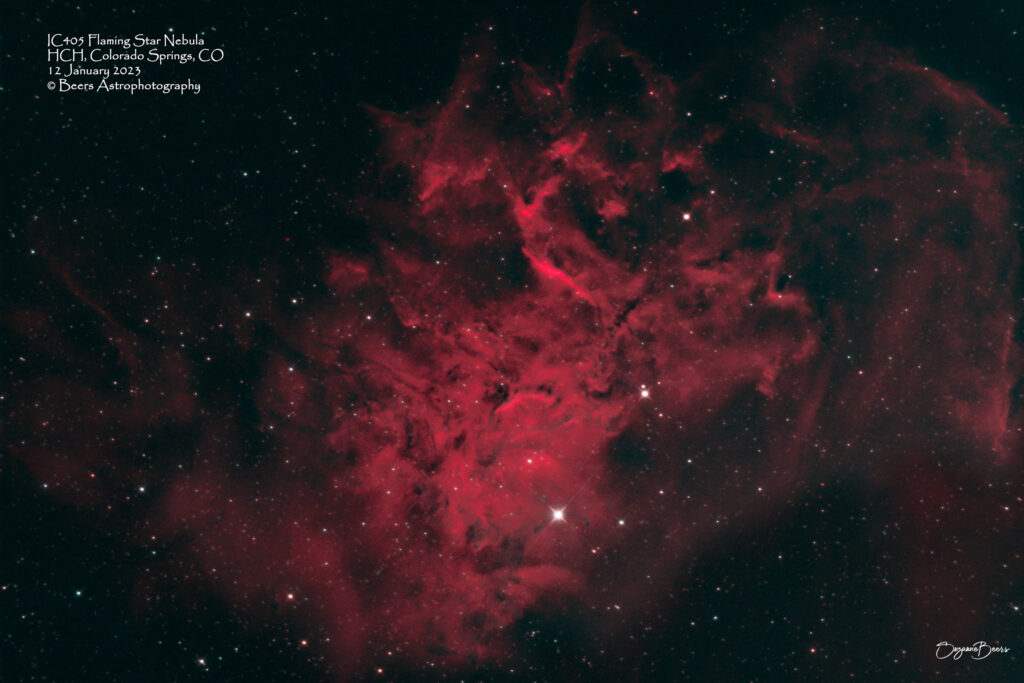
Target Fun Facts
IC 405 (also known as the Flaming Star Nebula, SH 2-229, or Caldwell 31) is an emission and reflection nebula in the constellation Auriga north of the celestial equator, surrounding the bluish, irregular variable star AE Aurigae. It shines at magnitude +6.0. It is located near the emission nebula IC 410 (Tadpole Nebula), the open clusters M38 and M36, and the K-class star Iota Aurigae.
The nebula measures approximately 37.0′ x 19.0′, and lies about 1,500 light-years away from Earth. It is believed that the proper motion of the central star can be traced back to the Orion’s Belt area. The nebula is about 5 light-years across.
Distance: 1500 light years
Radius: 2.5 light years
Apparent Dimensions: 37’ x 10’
Apparent Magnitude: +6.0
Constellation: Auriga
Designations: Flaming Star Nebula, Caldwell 31, Sharpless 229
{ Target information from: https://en.wikipedia.org/wiki/IC_405 }
Capture Notes
This image was captured on the last night of our 29-31Dec2024 dark skies trip to Mills Canyon Rim in New Mexico’s Kiowa National Grasslands. (Our last night because we decided we had had enough of the day-long 25+ mph winds.) I hadn’t rushed to have or clean up after dinner because the crazy winds weren’t supposed to die down until about 20:00MST. I went out to take Zeus for a walk and was surprised and pleased to find that it was calm. I got Big Bertha going on her target(s) for the night first, since she was going to capture three (CTB1 Garlic, M78 Casper, and SH2-261 Lower’s) to the Southern Cross’ single target, IC 405 Flaming Star Nebula.
I got the sequence started and found myself in the midst of SGPro’s CW-CCW-CW-CCW camera rotation game. You know after the first back-and-forth, it isn’t going to end well! I aborted the sequence – validated that the camera was on the 90° mark and validated that SGP was expecting it to be on 90°. Then it occurred to me that I hadn’t changed the user profile from our “standard” Mills Canyon Rim K90A location to the new one that we were using “in the trees” (a difference of 200 feet!). I went into the User Profile tab and changed the coordinates to the current location, restarted the sequence and it worked like a charm (the rotation angle from my eyeballing it to my 90° mark was off by 3.17°)! It is amazing to me that the calculations in the plate solver are that sensitive, and that it would manifest itself in camera rotation angle confusion.
Everything went well (with DSO-CTRL1 wrapped in only a towel as the temperatures plunged to 17°F overnight. The sequence was started by 19:27MST, I came out and accomplished the meridian flip at 22:35 (switched targets on BB at that point), and imaged until IC405 set at 04:28MST.
Sequence Plan (30Dec2024): Gain: 158, Temp: -0°C, offset=30. 100x300sec. Total: 500 minutes (8:20hrs). Captured 30Dec2024, 19:27MST – 31Dec2024, 0447MST.
Equipment
Equipment: All equipment controlled by HP Probook DSO-CTRL1 running Sequence Generator Pro v4.4.1.1441.
- Imaging (ASI2400-BB-FF): ZWO ASI2400MC imaging camera on (Southern Cross) Askar FRA600 108mm f/5.6 Quintuplet Petzval Flat-Field Astrograph
- Autofocuser: ZWO EAF Electronic Automatic Focuser (EAF-5V-STD)
- Mount: Rainbow Astro RST-135E (controlled by iHubo ASCOM driver)
- Polar alignment: QHYCCD camera (controlled by Polemaster for polar alignment)
- Autoguiding: Orion 60mm Multi-Use Guide Scope with Orion StarShoot AutoGuider Pro Mono Astrophotography Camera (controlled by PHD2)
Summary
Captured: 30 December 2024. 100x300sec. Total: 500 minutes (8:20hrs).
Shooting Location: Mills Canyon Rim, Kiowa National Grasslands, New Mexico
Processing: Captured in SGP, stacked in APP (Adaptive Airy Disc), star removal with Starnet++, processing with LR/PS
Other images IC405 Flaming Star Nebula

Capture Notes
This image, captured at Mills Canyon, Kiowa National Grasslands, 4 November 2021 (early in my astrophotography experience), shows the value of dark skies. The other images on this page were captured from Bortle 6 Colorado Springs. In dark skies, I used less than half the total exposure time (3:24hrs vs. 7:50hrs, 3min vs. 5min exposures, ISO800 vs. ISO3200) to produce a much more richly colored image (with very nascent processing skills!).
Sequence Plan: ISO800; 68x180sec. Total exposure time: 3:24hrs. Captured 5Nov2021, 0016 – 0353MST.
Equipment
Polar alignment: QHYCCD camera (controlled by Polemaster)
Imaging stream: Orion 8″ f/8 Ritchey-Chretien Astrograph Telescope, Canon EOS Ra
Mount: Sky-Watcher EQ6-R Pro Equatorial Mount (controlled by EQMOD)
Autoguider: Orion 60mm Multi-Use Guide Scope, Orion StarShoot AutoGuider Pro Mono Astrophotography Camera (controlled by PHD2)
All equipment controlled by HP Probook running Sequence Generator Pro v3.2.0.660.
Summary
Captured: 5 November 2021
Shooting Location: Mills Canyon, Kiowa National Grasslands, New Mexico
Equipment: Canon EOS Ra on Big Bertha, EQ6-R mount

Capture Notes
This image was captured from the Bortle 6 skies of Colorado Springs on a surprise clear night, in the middle of a (past and future) period with no hopes of seeing them, popped into the forecast after dinner….verified with a look outside – yeah, clear skies! It was forecast to be clear from that point until about 0100MST. Given the lack of clear skies in the last couple of months and the forecast for none in the near future, I didn’t want to pass up the opportunity. So, I quickly wheeled Big Zeus out onto the patio and built an SGP sequence for RaBZ using the field flattener and LeXtreme filter against the 76.5% waning gibbous moon. By 1900, I had the sequence going. It turned out they also had the “clouds rolling in” forecast wrong – it was clear all night! So I was able to image until the target set behind the SE corner of the roof, as about 0315…just in time to take my calibration frames and get things picked up and rolled inside before leaving for my run with Susie and Danielle.
Sequence Plan: ISO3200; 94x300sec. Total exposure time: 7:50hrs. Captured 12Jan2023, 1900MST – 13Jan2023, 0317MST.
Equipment
Polar alignment: QHYCCD camera (controlled by Polemaster)
Imaging stream: Orion 10″ f/8 Ritchey-Chretien Astrograph Telescope, Canon EOS Ra with with Teleskop Service Flattener 1.0x for RC Telescopes (TS-RCFLAT2) and Optolong L-Extreme LP filter
Mount: Sky-Watcher EQ6-R Pro Equatorial Mount (controlled by EQMOD)
Autoguider: Orion 60mm Multi-Use Guide Scope, Orion StarShoot AutoGuider Pro Mono Astrophotography Camera (controlled by PHD2)
All equipment controlled by HP Probook running Sequence Generator Pro v3.2.0.660.
Summary
Captured: 12 January 2023
Shooting Location: HCH, Colorado Springs, Colorado
Equipment: Canon EOS Ra on Big Zeus, EQ6-R mount

Capture Notes
Not being able to leave well enough alone, I decided to process the 10% stretched stack, to see if the final version would be less noisy. My thoughts on the result – some of the fainter nebulosity is lost, but the increase in clarity allows more of the details in the heart of the nebula.
Sequence Plan: ISO3200; 94x300sec. Total exposure time: 7:50hrs. Captured 12Jan2023, 1900MST – 13Jan2023, 0317MST.
Equipment
Polar alignment: QHYCCD camera (controlled by Polemaster)
Imaging stream: Orion 10″ f/8 Ritchey-Chretien Astrograph Telescope, Canon EOS Ra with with Teleskop Service Flattener 1.0x for RC Telescopes (TS-RCFLAT2) and Optolong L-Extreme LP filter
Mount: Sky-Watcher EQ6-R Pro Equatorial Mount (controlled by EQMOD)
Autoguider: Orion 60mm Multi-Use Guide Scope, Orion StarShoot AutoGuider Pro Mono Astrophotography Camera (controlled by PHD2)
All equipment controlled by HP Probook running Sequence Generator Pro v3.2.0.660.
Sequence Plan
Captured: 12 January 2023
Shooting Location: HCH, Colorado Springs, Colorado
Equipment: Canon EOS Ra on Big Zeus, EQ6-R mount
